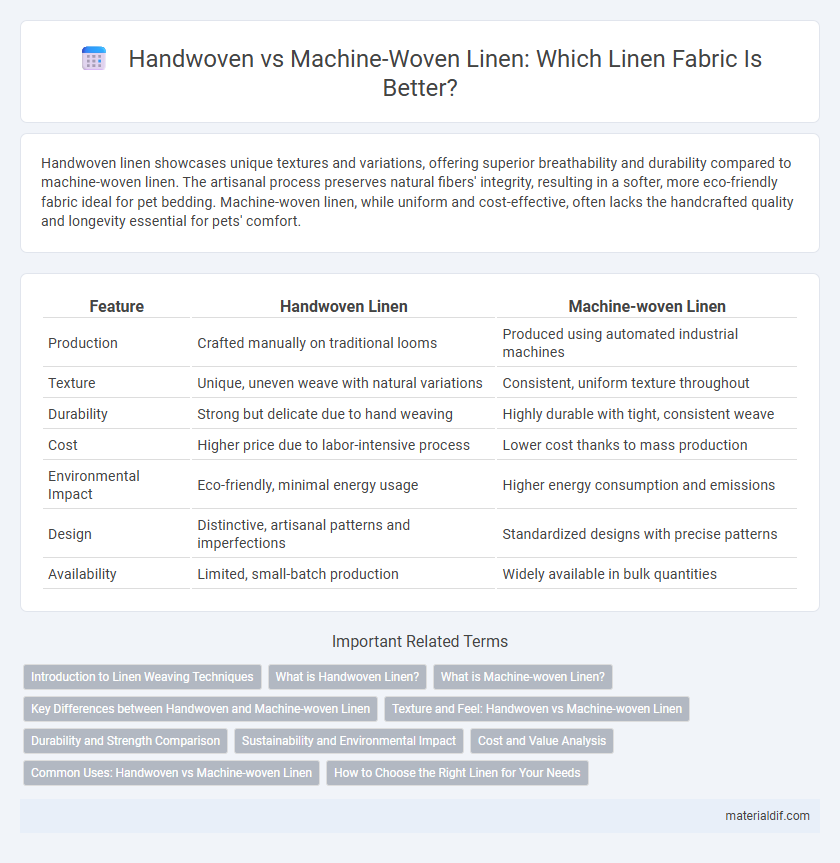Handwoven linen showcases unique textures and variations, offering superior breathability and durability compared to machine-woven linen. The artisanal process preserves natural fibers' integrity, resulting in a softer, more eco-friendly fabric ideal for pet bedding. Machine-woven linen, while uniform and cost-effective, often lacks the handcrafted quality and longevity essential for pets' comfort.
Table of Comparison
| Feature | Handwoven Linen | Machine-woven Linen |
|---|---|---|
| Production | Crafted manually on traditional looms | Produced using automated industrial machines |
| Texture | Unique, uneven weave with natural variations | Consistent, uniform texture throughout |
| Durability | Strong but delicate due to hand weaving | Highly durable with tight, consistent weave |
| Cost | Higher price due to labor-intensive process | Lower cost thanks to mass production |
| Environmental Impact | Eco-friendly, minimal energy usage | Higher energy consumption and emissions |
| Design | Distinctive, artisanal patterns and imperfections | Standardized designs with precise patterns |
| Availability | Limited, small-batch production | Widely available in bulk quantities |
Introduction to Linen Weaving Techniques
Handwoven linen showcases intricate craftsmanship achieved through traditional loom techniques, resulting in unique textures and enhanced durability. Machine-woven linen, produced by automated industrial looms, offers consistency in weave patterns and faster production times. Both methods utilize flax fibers but differ significantly in texture, strength, and artisanal value.
What is Handwoven Linen?
Handwoven linen is crafted using traditional looms where artisans manually interlace flax fibers, creating unique textures and intricate patterns that reflect cultural heritage and craftsmanship. This method produces fabric with higher durability, breathability, and natural irregularities that enhance its aesthetic appeal compared to uniform machine-woven linen. The handwoven process often results in eco-friendly textile production with reduced energy usage and minimal chemical treatment, appealing to sustainable fashion enthusiasts.
What is Machine-woven Linen?
Machine-woven linen is produced using automated looms that interlace flax fibers at high speed, ensuring uniform texture and consistent fabric strength. This method allows for large-scale production with precise control over thread density and weave patterns, resulting in durable, affordable linen textiles. The mechanized process often reduces production time and costs compared to traditional handwoven techniques while maintaining the natural breathability and hypoallergenic properties of linen.
Key Differences between Handwoven and Machine-woven Linen
Handwoven linen is crafted using traditional techniques involving manually operated looms, resulting in unique textures and slight irregularities that enhance its artisanal appeal. Machine-woven linen, produced on automated industrial looms, offers uniformity, higher production speed, and consistent weaving patterns. The durability of machine-woven linen generally surpasses handwoven linen due to precise tension control, but handwoven linen provides superior breathability and a distinctive, handcrafted aesthetic.
Texture and Feel: Handwoven vs Machine-woven Linen
Handwoven linen exhibits a unique, irregular texture with natural variations that provide a soft, breathable feel, enhancing its artisanal charm. Machine-woven linen offers a uniform, smooth surface with consistent fiber alignment, resulting in a more durable and polished fabric. The tactile difference is evident, as handwoven linen feels more organic and textured, while machine-woven linen feels sleek and refined.
Durability and Strength Comparison
Handwoven linen generally features tighter, more varied thread tension, resulting in enhanced durability and unique strength characteristics compared to machine-woven linen, which offers uniformity but can be more prone to wear over time. The traditional weaving techniques used for handwoven linen create a robust fabric structure that resists stretching and tearing better under stress. Machine-woven linen, while consistent in texture, may lack the resilience found in artisan-crafted handwoven textiles, making handwoven linen preferable for high-durability applications.
Sustainability and Environmental Impact
Handwoven linen typically has a lower environmental impact than machine-woven linen due to its artisanal production methods, which use less energy and minimize carbon emissions. The manual weaving process preserves natural fibers without relying on synthetic chemicals often involved in mechanized fabric manufacturing. Supporting handwoven linen promotes sustainable agriculture and traditional craftsmanship, reducing waste and fostering eco-friendly practices in the textile industry.
Cost and Value Analysis
Handwoven linen commands a higher price due to the labor-intensive craftsmanship and unique texture, offering superior durability and exclusivity compared to machine-woven linen. Machine-woven linen, while more affordable and consistent in appearance, may lack the artisanal quality and subtle irregularities prized in handwoven textiles. Evaluating cost against long-term value, handwoven linen presents a premium investment favored by consumers seeking authenticity and enhanced tactile experience.
Common Uses: Handwoven vs Machine-woven Linen
Handwoven linen is commonly used for artisanal home textiles, such as decorative table runners, throw pillows, and bespoke clothing, prized for its unique texture and durability. Machine-woven linen is widely utilized in mass-produced garments, bedding, and upholstery fabrics, offering consistent quality and affordability. Both types serve distinct market demands, with handwoven linen favored for craft and luxury items, while machine-woven linen dominates in everyday textile applications.
How to Choose the Right Linen for Your Needs
Handwoven linen offers unique texture and durability due to traditional craftsmanship, making it ideal for artisanal bedding or decor that values authenticity. Machine-woven linen provides consistency, affordability, and uniformity, suitable for large-scale production and everyday use. Choose handwoven linen for premium quality and character, while machine-woven linen fits practical, budget-conscious needs without sacrificing comfort.
Handwoven Linen vs Machine-woven Linen Infographic

 materialdif.com
materialdif.com